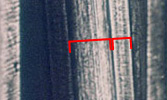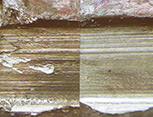Home | Glossary | Resources | Help | Contact Us | Course Map
Archival Notice
This is an archive page that is no longer being updated. It may contain outdated information and links may no longer function as originally intended.
Class and Individual Characteristics
All evidence bears class characteristics. Individual characteristics may or may not be present.
Evidence that possesses class characteristics may be referred to as class evidence. Similarly, evidence that possesses individual characteristics may be referred to as individual evidence.
Both class and individual evidence have value; however, it typically takes considerably more class evidence (and time for collection and analysis) to have the same weight and significance as a single item of individual evidence.
Criminal cases based solely on class evidence are more difficult to prove and require more work, but the results can be just as significant. To put it in perspective, in terms of probative value in the courtroom, it usually takes a considerable combination of class evidence to equate to a single item of individual evidence.
| Class and Individual Characteristics | ||
| Characteristic | Definition | Examples |
| Class Characteristics |
Measurable features of an item that indicate a restricted group source based on design factors determined prior to manufacture May be shown to be like or consistent with a questioned source, although not uniquely identifiable with that source |
Width of the tip of a screwdriver Width of land and groove impressions Bloodstain |
| Subclass Characteristics |
Discernible surface features of an object, more restrictive than class characteristics Produced incidental to manufacture Refer to a smaller group source (a subset of the class to which they belong) May arise from a source that changes over time |
Marks on an object produced by a grinding wheel or sanding belt. Manufacturing marks on a group of Ruger firearms Blood type |
| Individual Characteristics |
Marks on an object produced by the random imperfections or irregularities on the surfaces of the tools used to manufacture the object Produced incidental to the manufacturing process and typically seen at microscopic level Can be produced on an object by use, abuse, and/or corrosion May be uniquely identifiable with a source |
Striated and/or impressed marks produced by the action of the tip of a screwdriver on an object Striation marks on a fired bullet DNA profile from a bloodstain |
Additional Online Courses
- What Every First Responding Officer Should Know About DNA Evidence
- Collecting DNA Evidence at Property Crime Scenes
- DNA – A Prosecutor’s Practice Notebook
- Crime Scene and DNA Basics
- Laboratory Safety Programs
- DNA Amplification
- Population Genetics and Statistics
- Non-STR DNA Markers: SNPs, Y-STRs, LCN and mtDNA
- Firearms Examiner Training
- Forensic DNA Education for Law Enforcement Decisionmakers
- What Every Investigator and Evidence Technician Should Know About DNA Evidence
- Principles of Forensic DNA for Officers of the Court
- Law 101: Legal Guide for the Forensic Expert
- Laboratory Orientation and Testing of Body Fluids and Tissues
- DNA Extraction and Quantitation
- STR Data Analysis and Interpretation
- Communication Skills, Report Writing, and Courtroom Testimony
- Español for Law Enforcement
- Amplified DNA Product Separation for Forensic Analysts




